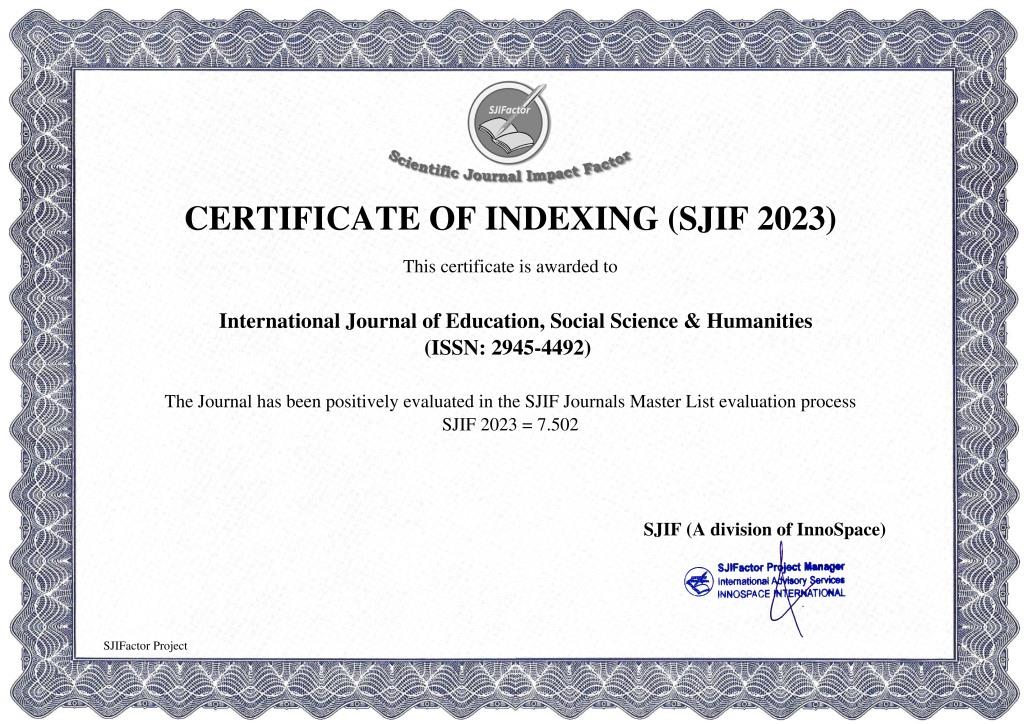FERNS OF THE KORATEPA RESERVOIR
Keywords:
diversity; fern; transectAbstract
In this article, the ferns found around the Karatepa reservoir were studied and their taxonomy was compiled. The condition of the sedges growing around the stream was assessed using mathematical and statistical methods.
References
Zakirov K.Z. Flora and vegetation of the Zeravshan River basin. T. 1-2. – Tashkent: Publishing House of the Academy of Sciences of the UzSSR, 1955, 1962. – 7-9 p.
Komiljon Sh. Tojibaev, Natalya YU. Beshko et. al. Inventory of the flora of Uzbekistan: Samarkand region. Tashkent: Publishing house. Fan. Academy of Sciences of the Republic of Uzbekistan, 2018, 47-48 p.
Jina J, Wang Q, Wanga J, et al. Tracing water and energy fluxes and reflectance in an arid ecosystem using the integrated model SCOPE. J Environ Manage. 2019;231:1082–1090. DOI:10.1016/j.jenvman.2018.10.090
Abotsi KE, Bose R, Adjossou K, et al. Ecological drivers of pteridophyte diversity and distribution in Togo (West Africa). Ecol Indic. 2020;108:105741. DOI: 10.1016/j.ecolind.2019.105741
Olsson O, Gassmann M, Manig N, et al. Basin efficiency approach and its effect on streamflow quality, Zerafshan River Uzbekistan. Journal of Hydrology Volume 476, 7 January 2013, Pages 128-135. DOI: 10.1016/j.jhydrol.2012.10.022
Feng-Chun Yang, Chaya Sarathchandra, Jing-Xin Liuf, Hua-Ping Huangg, et al. How fern and fern allies respond to heterogeneous habitat — a case in Yuanjiang dry-hot valley. Communicative & Integrative Biology 2021, vol. 14, no. 1, 248–260 https://doi.org/10.1080/19420889.2021.2007591
Meteoblue. Climate Change Samarkand. Samarqand Region, Uzbekistan, 39.65°N 66.96°E, 719m asl https://www.meteoblue.com/en/climate-change/samarkand_uzbekistan_1216265
PPG I (2016), "A community-derived classification for extant lycophytes and ferns", Journal of Systematics and Evolution, 54 (6): 563–603. DOI: 10.1111/jse.12229
Flora of Uzbekistan. T. 1-6. – Tashkent: Publishing House of the Academy of Sciences of the UzSSR. 1941. 7-91 p.
Chao A, and Chiu CH . Bridging the variance and diversity decomposition approaches to beta diversity via similarity and differentiation measures. Meth Ecol Evolut. 2016;7(8):919–928 doi:https://doi.org/10.1111/ 2041-210X.12551
Magurran AE. Measuring biological diversity. New York: Blackwell; 2004
Ricotta C, Podani J. On some properties of the Bray-Curtis dissimilarity and their ecological meaning. Ecol Complexity. 2017;31:201–205. DOI: 10.1016/j.ecocom.2017.07.003
Hernández-Rojas A, Kessler M, Krömer T, et al. Richness patterns of ferns along an elevational gradient in the Sierra de Juárez, Oaxaca, Mexico: a comparison with central and South America. Am Fern J. 2018;108 (3):76–95. DOI: 10.1640/0002-8444-108.3.76
Kessler M, Parris BS, Kessler E. A comparison of the tropical montane pteridophyte floras of Mount Kinabalu, Borneo, and Parque Nacional Carrasco, Bolivia. J Biogeograph. 2001;28(5):611–622. DOI: 10.1046/j.1365-2699.2001.00577.x
Salazar L, Homeier J, Kessler M, et al. Diversity patterns of ferns along elevational gradients in Andean tropical forests. Plant Ecolog Divers. 2015;8(1):13–24. DOI: 10.1080/17550874.2013.843036
Kessler M, Kluge J, Hemp A, et al. A global comparative analysis of elevational species richness patterns of ferns. Global Ecol Biogeogr. 2011;20 (6):868–880.DOI: 10.1111/j.1466-8238.2011.00653.x
Brock JM, Perry GL, Lee WG, et al. Tree fern ecology in New Zealand: a model for southern temperate rainforests. For Ecol Manage. 2016;375:112–126. DOI: 10.1016/j.foreco.2016.05.030














